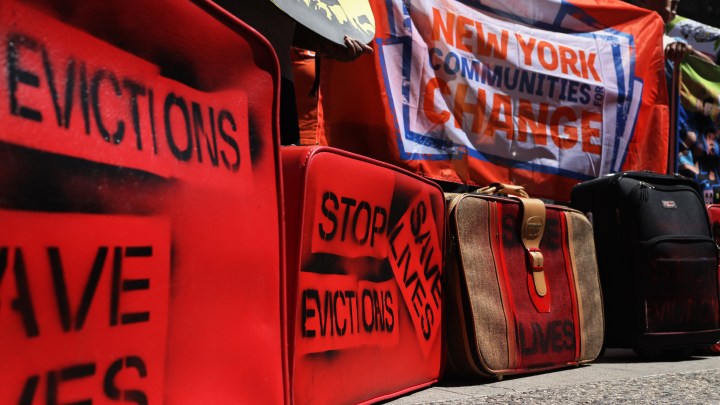
Eviction filings hit pre-pandemic levels a year after the end of the moratorium
Eviction filings hit pre-pandemic levels a year after the end of the moratorium

During the height of the pandemic, the CDC passed an eviction moratorium, preventing landlords from evicting tenants for missing rent payments. Congress also passed legislation providing financial relief to renters, but, many times, the aid didn’t always reach those who needed it.
Last year, the Supreme Court struck down the CDC’s eviction moratorium, and less than a year later, the eviction crisis has returned.
Rising rent prices and a 40-year peak in inflation haven’t helped the situation. Rent prices have risen by 12.3% year-over-year and hit a peak of almost 18% from the beginning of the year, according to Apartment List. About 36% of Americans currently rent their form of housing, and because many renters are young people, racial minorities and those with lower incomes, they are disproportionately affected by rent hikes and evictions.
Setting policies to solve the eviction crisis is more complicated than it may appear. There is no federal database tracking nationwide evictions. Carl Gershenson, the project director at Princeton University’s Eviction Lab says “…the long-term goal has to just be structurally changing this untenable housing system that we have.”
Gershenson spoke to Marketplace host Kai Ryssdal about the state of the eviction crisis and the role of the government in addressing housing needs. The following is an edited transcript of this conversation.
Carl Gershenson: Eviction activity in the United States looks like it’s returning approximately to where it was before the pandemic. If you look at our data going from 2000, up to around 2018, it’s just really steady. Like, the same communities see just about the same number of evictions year after year. And it was the massive federal interventions that we saw in the wake of the coronavirus — that was really the only time in history that we’ve seen a significant reduction in eviction activity. So now, two years later, with the protections expired, with most of that rental aid running out, it looks like we are right back where we started.
Kai Ryssdal: Just super quick, so that everybody picks up on the word to use: “communities.” We’re talking here mostly about communities of color and communities on the lower end of the income spectrum.
Gershenson: That’s correct. You know, there is sort of a fractal pattern with the geography of evictions. If you want to know which region of the country has the highest eviction rates, you know, look for regions of the country with large black populations. If you want to know which neighborhoods in those states experience high levels of eviction, again, you’d look for the most segregated neighborhoods.
Ryssdal: It’s my understanding that there is no comprehensive tracking of evictions at the federal level, that, in fact, the Eviction Lab that you run is the biggest and best data set. And it, of course, brings to mind — maybe it was Peter Drucker, I don’t know — but the whole “you can’t manage what you don’t measure” thing. How can we handle an eviction crisis without knowing the numbers?
Gershenson: That’s exactly right. And we think that this is something, which, really, it will take the federal government to invest in if we want up-to-date information about eviction filing rates, everywhere in the country. You know, if we can get the data anyone can, including credit companies and tenant screening companies. And so there is this real tension between wanting to protect the privacy of renters and allowing researchers to study it. So you can only solve that tension if it’s the federal government who is collecting this and selectively disclosing these data.
Ryssdal: So what would it take to put the Eviction Lab out of work, to make you lose your job, right? I mean, because ideally, evictions would fall to zero, and you wouldn’t have a place to go in the morning. What would that take?
Gershenson: I think that it would take this country seriously investing in housing and seriously tackling poverty. You know, 80% of renters who earn under $25,000 are rent burdened. You know, that means that they spend more than 30% of their already small income on rent. And we’ve seen what rents have done in the last two years, there’s no indication that they’re going to go down. So the squeeze on these low-income renters is just getting worse and worse. And, you know, middle-income renters are hurting too — not as badly as low-income renters — but as rent levels go up, you know, everyone’s feeling this more and more. You really need to tackle this from both sides. I mean, people need money. But we also need to make it easier and more affordable to build housing, of high quality where people want to live.
Ryssdal: And even if Congress decided to do that tomorrow, it’s a decades’ long challenge. Right?
Gershenson: Exactly. And there’s all sorts of things that we can do in the short- to medium-term that can stabilize tendencies, and that’s where you get into all sorts of renter protection bills, like a right to counsel. You know, most tenants are not represented if they go to housing court. Things like that can help people stay in their homes, but the long-term goal has to just be structurally changing this untenable housing system that we have.
There’s a lot happening in the world. Through it all, Marketplace is here for you.
You rely on Marketplace to break down the world’s events and tell you how it affects you in a fact-based, approachable way. We rely on your financial support to keep making that possible.
Your donation today powers the independent journalism that you rely on. For just $5/month, you can help sustain Marketplace so we can keep reporting on the things that matter to you.

















